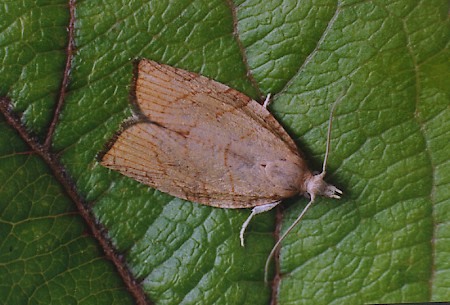49.024 BF969
Chequered Fruit-tree Tortrix Pandemis corylana
(Fabricius, 1794)
Wingspan 18-21 mm.
The reticulations on the forewing of this species give rise to its English name, although the intensity of these varies somewhat.
The moth flies in July and August, and is fairly common over most of Britain, especially in woodland areas.
The larvae feed on a wide variety of deciduous trees, rolling the leaves in a manner characteristic of the Tortricidae.
Larva: (description Ian F. Smith)
Foodplants:
May to July in spun leaves or longitudinally folded leaf of many trees and shrubs including Corylus, Fraxinus, Prunus, Quercus, Rubus and Swida sanguinea.
Late instar:
Length: 20 mm
Head: Emerald green frons. Capsule; green overlaid by light brown and yellowish brown on cuticle. Mouthparts dark brown. Black postero-lateral mark. Stemmata black, but intervening stemmatal area mainly green.
Prothorax: Translucent jade green, showing dark viscera dorsally. Prothoracic shield; pairs of black spots and, laterally, black crescent.
Thoracic legs: Translucent pale green with pale brown claw.
Body: Translucent jade or emerald green darkened dorsally by viscera. Contractile dorsal vessel shows as darker dorsal line.
Spiracles: Whitish green with fine pale brown peritreme. Largest on A8 & T1.
Pinacula: Concolorous, unobtrusive.
Setae: Translucent pale grey.
Anal plate: Concolorous.
Prolegs: Concolorous. Crochets reddish brown.
Similar species: 970 Pandemis cerasana is very similar. The black markings on the prothoracic plate are almost identical, but perhaps finer on corylana. The body is usually jade or emerald green in corylana and apple green in cerasana. Time of year should help separate them; cerasana is a larva over winter from September to May, corylana from May to July. In May cerasana is full grown while corylana is in early instar. Until more illustrations and descriptions are available of other related Tortricid larvae, identification should be confirmed by raising the larvae.

 UKMoths
UKMoths 




